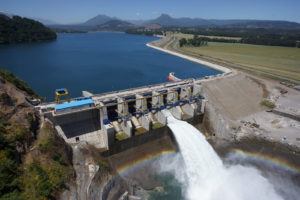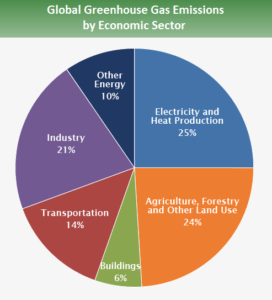COLBÚN AND ITS LEADERSHIP IN THE CHILEAN ENERGY INDUSTRY

The energy industry has long been the target for some of the biggest campaigns for global warming, as well as one of the most regulated industries in this matter. This is mainly because the energy industry is the largest producers of CO2,which is in turn the biggest gas contributor among the greenhouse gases.
Colbún, a power generation company in Chile, is facing this challenges and pushing to be one of the leaders in the country regarding sustainability and climate change control.
The energy industry has long been the target of some of the biggest campaigns against global warming, as well as one of the most regulated industries in this matter. This is mainly because the energy industry is the largest producer of CO2 (with 35% of total share by industry (1)), which is in turn the biggest gas contributor among the greenhouse gases with 76% of the total share (2).
To set some context, Colbún is the second largest power generation company in Chile, with a total installed capacity of 3,278 MW. Chile’s government has ratified the Kyoto Protocol as well as signed the Paris Agreement (this last an agreement between members of the UN) (3) with the intention to decrease the emissions on a national level and show its commitment to help with this worldwide problem. In turn, the government has issued a series of laws to address this issue, going from limitations to households’ emissions to industry level regulations.
This last part affects Colbún directly, as some of the most stringent laws adopted by the government were aimed towards the generation industry. In particular, the biggest law going around is the so-called “20/25 law”, which states that by the year 2020 at least 25% of the generation of a company has to come from Non-Conventional Renewable Energy (NCRE) sources, a big jump from the 6% that was stated for the year 2014.
This poses many challenges for the energy industry in general, and for Colbún as part of the industry. One challenge is related with the investment needed to build these new facilities, which in the power generation industry means billions of dollars with usually long construction leadtimes and even longer return periods. According to a research from the Pontificia Universidad Católica de Chile (the country’s most prestigious university), it will cost the country $31 billion dollars to meet this law (4), something around 10% of the nation’s GDP. This translates into a cost of $68/MWh that is injected to the system, and that most likely the generation companies will have to incur.
This cost is in part explained by another difficulty of incorporating NCRE to the system, which is given by the intermittent source of energy that these types of power plants present. Given that a solar plant or a wind farm do not generate electricity all day (because of no production during night time or unstable wind patterns throughout the day, respectively), a company must invest to have a “back-up” facility during those hours. Since this back-up facility only works during the NCRE plant off hours, the initial investment is then divided by a fewer number of hours, increasing the fixed component of the energy cost.
Third, the company faces reputational risks, as most companies nowadays. In the case of Colbún this can go to the point of people protesting outside its facilities and having them shut down the plant, or as it happened with an emblematic project named HydroAysén, people’s protests made the Supreme Court revoke the original legal and environmental permit the company had to build the plant.
The company has worked not only to meet the requirements but to exceed them and be a leading player in sustainability. Colbún has voluntarily created a Sustainability Report in which it shows everything the company is doing to address these issues and to provide to the public all the figures to evaluate the company’s performance in this regard. It also created an online live emissions control panel of this thermal plants. All of this is obviously possible by practices to reduce the emissions, such as filters in the plants, using the newest technology available, mitigation plans and other similar practices. Also, the company has sold carbon bonds in international markets for a total equivalent to retiring 885,000 cars of the streets (5). In addition, the company continuous to invest in sustainable energy, which translates in the acquisition of a wind farm in 2015, and of a solar plant in 2016. As a recognition of all this good practices, the company’s Angostura project won the award of Sustainable Project of the Year by Cigré in 2014 (International Council of Large Electric Systems, based in Paris), and in 2015 the SOFOFA (Federation of Chilean Industry) awarded Colbún with the Sustainable Corporation of the Year. All of these were leaded by the Chief Sustainability Officer, a position created by the CEO years ago to help the company lead the way in these matters.
 Angostura project. Source: www.centralangostura.cl
Angostura project. Source: www.centralangostura.cl
The company is doing a good job in leading the way in a national level towards sustainability. It should continue to do so, and push to always be in the front of these, and not fall behind because it thinks it has done a good job so far.
Word count: 791.
- US Environmental ProtectionAgency, “Global Greenhouse Emissions Data”, https://www.epa.gov/ghgemissions/global-greenhouse-gas-emissions-data. Accessed Nov. 3, 2016.
- US Environmental ProtectionAgency, “Global Greenhouse Emissions Data”, https://www.epa.gov/ghgemissions/global-greenhouse-gas-emissions-data. Accessed Nov. 3, 2016.
- United Nations Framework Convention on Climate Change, “Paris Agreement – Status Ratification”, http://unfccc.int/paris_agreement/items/9444.php. Accessed Nov. 3, 2016.
- Revista Ei, http://www.revistaei.cl/2014/11/18/cumplir-con-la-ley-20-25-le-costaria-chile-unos-us31-000-millones/. Accessed Nov. 3, 2016.
- colbun.cl. Accessed Nov. 3, 2016.





Francisco – I enjoyed reading your post because of the great role that power generation companies will need to play in the unfolding saga to reduce climate change. I would like to learn more about the ways the Chilean government, with its track record of supporting innovation in the private sector, is encouraging new renewable energy projects to be developed, particularly in this low fuel price environment which makes alternative sources of energy less profitable. For example, the Chilean Atacama desert seems to provide great opportunities for solar power, is this being fully utilized? How closely are companies like Colbun working together with the government to structure these goals rather than simply being on the receiving end? A few interesting articles I ran into could help illuminate this:
http://www.nortonrosefulbright.com/knowledge/publications/134773/renewable-energy-in-latin-america-chile
https://jia.sipa.columbia.edu/renewable-energy-chile
Francisco, this article was interesting to me because the challenge which Colbun is facing now, which I understood includes the challenge in conducting a gradual shift of power plant portfolio to more renewables, is quite similar to the challenge which Japanese power producers are facing (which I wrote an article about). I am curious to know how Colbun is implementing this change. For example, are they using same investment evaluation methodology between fossil fuel power plant and renewables? Organizationally, how are they evaluating the performance of employees working at (perhaps) less profitable renewables division? Also, the strategy of Colbun seemed to be interesting; you mentioned in the post that Colbun is acquiring wind farm and solar power plant. Is the strategy of Colbun entering to renewable market by acquiring brown-field assets, with a long-term aim to take more development risk of the projects (i.e. green-field projects)? If so, in terms of the time horizon, how long do they envisage in implementing such strategy? I have witnessed some Japanese firms which managed to justify lower-risk/lower-return brown-field strategy as a tool to enter the new market; however, they got trapped there and still cannot move to higher-risk/higher-return green-field space.
Francisco, really a fascinating case study of how a government is using regulatory power to curb its national carbon footprint. However, I’m somewhat concerned about the sustainability of this regulation on the Chilean public. Requiring a private company to invest 10% of national GDP in development of renewable resources (if unsubsidized) feels to me like it could have one of two results: 1) the company becomes unprofitable if electricity prices are regulated by the government and this cost is not able to be passed on to the consumer, or 2) the public has to bear the burden of such a drastic increase in the cost of energy, and this leads to significant economic costs (particularly because energy costs have a disproportionate impact on lower-income groups, for whom a larger percentage of take-home income is devoted to basic staples, such as electricity), and this leads to a weakening of public will to support climate change measures and ultimately may lead to democratic repeal of legislation. I wonder if you have concerns over either of these, or if you see the societal cost born by this type of legislation as taking another form?